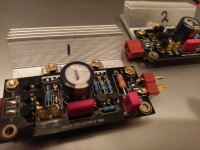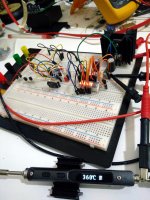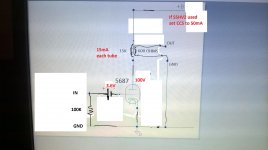Another couple of Reflektor-D Minis fired up successfully last night! 5.06V cold, 4.98V warm, heatsink 40C, pass MOSFET case 50C, 20R load almost 80C!
Thanks to Salas and Teabag for the concept, design, boards, and partial kits.
Thanks to sbelyo for posting his LED choices for the voltage I needed just as I was looking at assembling a test rig!
AND thanks to lykkedk for some posts back in the spring of 2017 on powering an RPi with a Reflektor-D.
Planned application trials include:
- SDtrans384
- RPi
- Linear-regulator-modified RPi (with output set to 6V)
- Allo Katana 5V DAC board and 5V microprocessor board
BTW, anyone consider using a PTC as the CCS current set resistor for an application such as an RPi? Initial turn on cold low resistance for a higher CCS current when first powered up to handle the RPi higher-current requirements of booting, then as the PTC heats up to thermal equilibrium a higher resistance for a lower CCS current for less heat generated during RPi run-time? I haven't checked the CCS R temps nor the PTC R ranges, likely have to parallel with a fixed R to get the appropriate R-delta. Will it be stable over time? Will the output voltage vary as the CCS current limit changes? Thoughts?
Greg in Mississippi
Thanks to Salas and Teabag for the concept, design, boards, and partial kits.
Thanks to sbelyo for posting his LED choices for the voltage I needed just as I was looking at assembling a test rig!
AND thanks to lykkedk for some posts back in the spring of 2017 on powering an RPi with a Reflektor-D.
Planned application trials include:
- SDtrans384
- RPi
- Linear-regulator-modified RPi (with output set to 6V)
- Allo Katana 5V DAC board and 5V microprocessor board
BTW, anyone consider using a PTC as the CCS current set resistor for an application such as an RPi? Initial turn on cold low resistance for a higher CCS current when first powered up to handle the RPi higher-current requirements of booting, then as the PTC heats up to thermal equilibrium a higher resistance for a lower CCS current for less heat generated during RPi run-time? I haven't checked the CCS R temps nor the PTC R ranges, likely have to parallel with a fixed R to get the appropriate R-delta. Will it be stable over time? Will the output voltage vary as the CCS current limit changes? Thoughts?
Greg in Mississippi
Attachments
@Salas,
Thanks for the response. I did take the time last night to check the temps on my 1R R1 last night... it went from ambient to about 50C fairly quickly... a few minutes or so. I'll look for some PTCs with a cold resistance of 1R-5R & hot in the 50R-200R range to parallel with my current 1R. Could make these setups work much better on powering things like Raspberry Pi's.
Thinking about it more last night, I'm also planning to add a 2000uf-4000uf cap in parallel with Cd, as I'll have at least 6"-9" of wire between any of my candidate raw DC supplies and the Reflektor Mini board. Any possible issues with this?
Greg in Mississippi
Thanks for the response. I did take the time last night to check the temps on my 1R R1 last night... it went from ambient to about 50C fairly quickly... a few minutes or so. I'll look for some PTCs with a cold resistance of 1R-5R & hot in the 50R-200R range to parallel with my current 1R. Could make these setups work much better on powering things like Raspberry Pi's.
Thinking about it more last night, I'm also planning to add a 2000uf-4000uf cap in parallel with Cd, as I'll have at least 6"-9" of wire between any of my candidate raw DC supplies and the Reflektor Mini board. Any possible issues with this?
Greg in Mississippi
BTW
Of course the Reflektor is superior for feeding dedicated circuitry but I am also working on an easily configurable steady voltage referenced Sziklai pair capacitance multiplier as a quiet general external supply for 2.5V to 18V output range. Adding lit segments to a bar-graph LED package with a jumper choosing output levels.
To can substitute SMPS adapters avoiding their switching noise in various gear like the RPI or small Class-D amps etc.
Not a regulator, a reliable low noise linear source of manageable dissipation in high peak amperage situations with some little sag (0.03-0.05 Ohm Zo) but no output to Vref feedback so to stay phase stable on anything. Here I used a soldering iron as its load and it did not break a sweat. Using a 15 Amps rated power amplifier grade fast transistor for its series pass element.
Of course the Reflektor is superior for feeding dedicated circuitry but I am also working on an easily configurable steady voltage referenced Sziklai pair capacitance multiplier as a quiet general external supply for 2.5V to 18V output range. Adding lit segments to a bar-graph LED package with a jumper choosing output levels.
To can substitute SMPS adapters avoiding their switching noise in various gear like the RPI or small Class-D amps etc.
Not a regulator, a reliable low noise linear source of manageable dissipation in high peak amperage situations with some little sag (0.03-0.05 Ohm Zo) but no output to Vref feedback so to stay phase stable on anything. Here I used a soldering iron as its load and it did not break a sweat. Using a 15 Amps rated power amplifier grade fast transistor for its series pass element.
Attachments
150mA for its own good spec will do, the grid bias application itself needs almost nothing for current. It should be completely floating i.e. the PSU out zero must have no continuity to the preamp's zero. Because you look to substitute a floating battery. You will need two isolated PSUs one for each channel exactly as you now have two isolated batteries in other words.
Salas,
How critical is the value of C2 at 1000uF/25V? Now that I have 2 Reflektor's running, I want to do some tuning. The minikit included Panasonic FC caps for this position. A bad long-past experience with the sonic signature of this series has me not using them in any of my builds. I'm considering United Chemicon KYB series caps as I use them a lot and have a number of values. I can stick with 1000uF, but I can go up to 8200uF from my stock. Any reason to stay with 1000uF?
TIA!
Greg in Mississippi
How critical is the value of C2 at 1000uF/25V? Now that I have 2 Reflektor's running, I want to do some tuning. The minikit included Panasonic FC caps for this position. A bad long-past experience with the sonic signature of this series has me not using them in any of my builds. I'm considering United Chemicon KYB series caps as I use them a lot and have a number of values. I can stick with 1000uF, but I can go up to 8200uF from my stock. Any reason to stay with 1000uF?
TIA!
Greg in Mississippi
Its the Vref filter cap so it can be influential. 1000uF was enough to filter well down below the 1/F noise corner across the couple of LEDs low impedance before becoming both too sizeable and its charge time to nominal Vout (maybe annoyingly) slow. But if you got favorite caps even in higher values that you wanna try its not a deal breaker.
Salas,
Thanks for your advice on C2. I now have a 3900uF/16V cap there and an 8200uF/16V cap at the DC input of the 2 Reflektor Mini's I have running. Both caps are from the United Chemicon KYB line, which have recently become my basic go-to cap for many mixed digital/analog and pure analog applications.
I'd originally set them up for fairly high current using a 1R set resistor try powering RaspberryPi music players. BUT I also wanted to test them powering an Allo.com Katana configured for 2 5V supplies and a separate +-15V supply for the output board. So I've gone to an 2R set resistor for the one powering the Microprocessor board (~20mA) and 1.5R for the one powering the DAC & Isolator boards (~200mA) to keep the temps more in line.
With the original C2 1000uF, no local reservoir C at the DC input and the high-current settings, the Reflektors were behind an MP Audio dual section 3||LT3045 regulator board in detailing and dynamics. Now the Reflektors are very competitive and after more break-in, may be my preferred option. One aspect I am enjoying from the Reflektors is a very solid, muscular, meaty, and palpable sense to the sound. But I'll need to give them more break-in time and then more comparisons.
Now I'll have to get a pair of the new UltraBiB to try for the +-15V rails.
Greg in Mississippi
Thanks for your advice on C2. I now have a 3900uF/16V cap there and an 8200uF/16V cap at the DC input of the 2 Reflektor Mini's I have running. Both caps are from the United Chemicon KYB line, which have recently become my basic go-to cap for many mixed digital/analog and pure analog applications.
I'd originally set them up for fairly high current using a 1R set resistor try powering RaspberryPi music players. BUT I also wanted to test them powering an Allo.com Katana configured for 2 5V supplies and a separate +-15V supply for the output board. So I've gone to an 2R set resistor for the one powering the Microprocessor board (~20mA) and 1.5R for the one powering the DAC & Isolator boards (~200mA) to keep the temps more in line.
With the original C2 1000uF, no local reservoir C at the DC input and the high-current settings, the Reflektors were behind an MP Audio dual section 3||LT3045 regulator board in detailing and dynamics. Now the Reflektors are very competitive and after more break-in, may be my preferred option. One aspect I am enjoying from the Reflektors is a very solid, muscular, meaty, and palpable sense to the sound. But I'll need to give them more break-in time and then more comparisons.
Now I'll have to get a pair of the new UltraBiB to try for the +-15V rails.
Greg in Mississippi
Greg hi,
Thanks for your detailed report. Other builders benefit from application examples. Discrete regs allow for additions, tweaks, and various parts quality substitutions. That's handy. How's your configuration of the raw DC supply to the Ref-D Minis? That info would complete the picture.
Thanks for your detailed report. Other builders benefit from application examples. Discrete regs allow for additions, tweaks, and various parts quality substitutions. That's handy. How's your configuration of the raw DC supply to the Ref-D Minis? That info would complete the picture.
- Home
- Amplifiers
- Power Supplies
- Reflektor-D builds


